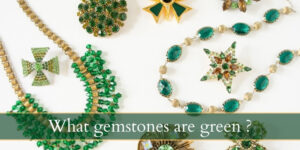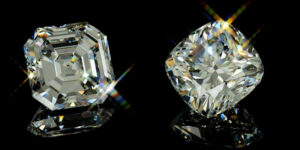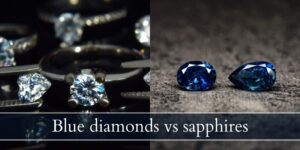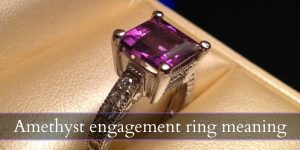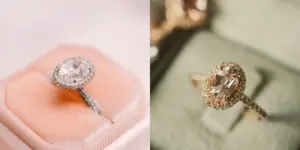Emeralds are some of the most beautiful gemstones out there, and they’re one of the original cardinal gems – those held in high regard, and only worn by nobility and high-ranking priests. These beautiful stones can be found across the world but were originally found in Egypt in ancient times. These are some of the oldest gemstones, and they’ve just as loved now as they were then.
You can find emerald mines in many countries now, and you can find the gemstones cut in all kinds of shapes. But one things remains the same: its color, or rather its hue. Emeralds are green, and they’ve always been green. They are the ultimate green gemstone. So what gives them that beautiful color ? And what makes some emeralds less vivid, and some blindingly green ? Let’s find out.
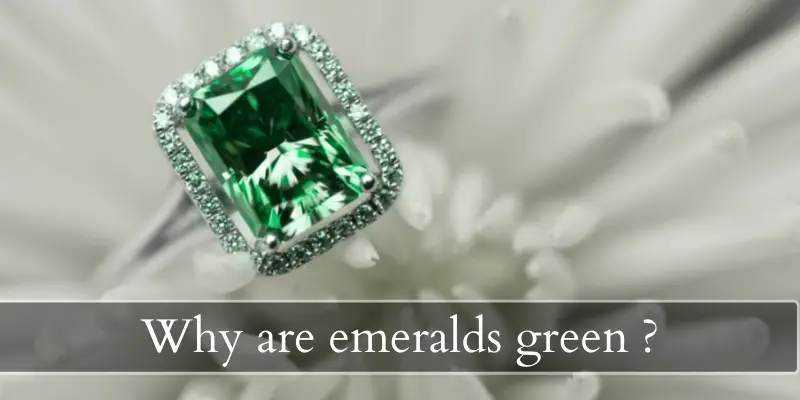
Why are emeralds green ?
Emeralds owe their green color to trace amounts of chromium, and sometimes to vanadium. The same element produces a red color in rubies. A small amount of iron also gives emeralds a bluish hue.
An ideal emerald is a deep, vivid green with high clarity and no other trace colors. Unfortunately not all emeralds are like this, because they are often riddled with inclusions and surface fractures, which make the emerald both cloudy and prone to breaking. Because of this emeralds are often treated to fill in those fissures.
What color emeralds are most expensive ?
Emeralds are graded by color intensity, and clarity is a close second. Thus an emerald that is a deep, medium-dark green with no obvious blue or yellow tint is more expensive than a lighter green emerald. But if the light green emerald is clearer than the darker one, it may fetch the same price, or even slightly higher.
True clarity in emeralds is incredibly rare, as this is a somewhat soft stone. It ranks a 7.5-8 on the Mohs scale of hardness, meaning it may fissure and scratch, and a lot of care needs to be take when cutting this stone.
Most emeralds appear a little cloudy due to inclusions – tiny imperfections of internal fissures. But the ones that don’t exhibit too many such inclusions and also achieve a deep green color are graded the highest.
These stones are often oiled or treated with a layer of polymers to fill in thin but noticeable cracks. Emeralds that have been thus treated are labeled as such, and this practice is widely accepted in the gemstone trade.
Read also: What Makes Diamonds Sparkle ?
Why are emeralds cut that way ?
Emeralds are by definition a somewhat brittle stone, and the grow in a long hexagonal shape, as a crystal. Because of its structure it is best suited to an emerald cut, so avoid breaking and chipping the stone as much as possible.
The emerald cut is a rectangular cut, with long cuts leading ‘into’ the stone, forming a step-cut. The edges were originally sharp 90 degree angles, but have since been tapered to avoid breaking the stone. Compared to other types of cuts the emerald cut has less facets, though it keeps true to the emerald stone’s original structure.
Emeralds often come in a specific cut, a long geometric cut that is very different from the faceted diamond cut we all know. You can get diamonds – and nearly any other stone – in an emerald cut, and it will always look bigger and more impressive.
This type of cut was very popular in the 1920s and 30s when art deco was the decorating trend. An emerald cut’s perfect geometry and the way it scatters the light fell right into the era’s trend.
Emerald gemstone alternatives
If you’re in love with emerald’s green color but don’t want to get an emerald, or can’t get one for various reasons, there are other green gemstones you can use in its place. To be fair not many gemstones can achieve the exact same shade as an emerald, but many do come close.
All of the below stones can be sourced by your jeweler on request, and most can be cut into a faceted stone, or a cabochon depending on your preference.
Peridot
Peridot is a green gemstone that has a different hue than emerald. Most emeralds lean towards a bluish-green, while peridot leans towards a yellowish dark green (olive green). Still, it may sit beautifully in a silver or white gold setting.
This stone has a 6.5-7 rating on the Mohs scale, so it will need protection. A bezel setting and/or carving into a cabochon may be a good idea.
Green garnet
Garnets come in various colors, ranging from a deep, dark red (almost brown) to yellow, and then deep, dark green. If you ask your jeweler he may be able to provide some green garnet for you, and it may come under the name uvarovite. A soft stone, it ranks a 6.5-7.5 on the Mohs scale. Great care needs to be taken when setting this stone, ask for a bezel setting and possibly a halo around it.
Green sapphire
Green sapphires are a bluish-green, though they may have some yellow hues here and there. They’re not the most common color of sapphire, but they can definitely stand in for emerald.
Being a sapphire, it is much harder than an emerald and thus you can choose nearly any setting type you like (claw, bezel, beading, anything you like). It scores a perfect 9 on the Mohs scale.
Jade
Jade is a very different gemstone than emerald, but it brings an amazing color, even if it’s not a clear stone. It can be carved into any shape you like, and it ranges from a light green to a deep green, depending on the grade you’re purchasing.
Due to its opacity, jade is best carved into a cabochon, rather than a faceted stone. Jade is somewhat translucent, but not enough to actually become clear. It’s also a soft, brittle stone, scoring a 6-7 on the Mohs scale.
Malachite
This is a deep, dark green mineral that resembles velvety stone in appearance. In its polished state it appears dark green with thin light green stripes of varying sizes. Really, this stone manages to be deeper, darker shade of green than emerald itself. It’s wholly opaque and very soft (3.5 – 4 on the Mohs scale) so a cabochon is the only way to wear it.
Because of its softness we recommend a bezel setting and wearing it either as earrings or a pendant. A ring or bracelet is too much wear and you risk fracturing the stone.
Tourmaline
Tourmaline comes in may colors, including green and a bluish green. The pure green one is also called Colombian emerald, after the site the mind was found. This stone is fairly soft (7 – 7.5 on the Mohs scale) so it may need a bezel setting. It’s pretty clear, so it can come in a faceted cut, or it can be a cabochon if you like.
Green cubic zirconia
If all else fails, you can get your green emerald in the form of cubic zirconia. These are lab-grown and they can thus b made any color you wish. The deepest, darkest green to the lightest green with a blue tint, if you wish. It’s also a more affordable stone than most on this list.
It has a 8-8.5 rating on the Mohs scale, so it’s not the most fragile stone but it can still scratch and chip at the edges. We recommend a bezel setting and surrounding it with a halo of similar stones.

I’m the main author for jewelrymaterialguide.com. I started this site after we did tons of research before our wedding and noticed that there is information about rings, jewelry, and so on that is really hard to find on the internet.

